The Effects of Cold Rolling and Annealing on the Microstructure Evolution of Ordered C-2000 Alloy during Metallic Wire Preparation
Abstract
1. Introduction
2. Materials and Methods
3. Results and Discussion
3.1. Microstructure of the As-Received Sample
3.2. Texture Components of the As-Received C-2000 Bar
3.3. Microstructure of the Annealed Samples
3.4. Evolution of Texture Components during Annealing
3.5. Nucleation Mechanism of the Annealed C-2000 Alloy during Recrystallization
4. Conclusions
Author Contributions
Funding
Institutional Review Board Statement
Informed Consent Statement
Data Availability Statement
Conflicts of Interest
References
- Borchers, C.; Kirchheim, R. Cold-drawn pearlitic steel wires. Prog. Mater. Sci. 2016, 82, 405–444. [Google Scholar] [CrossRef]
- Zhang, X.; Godfrey, A.; Huang, X.; Hansen, N.; Liu, Q. Microstructure and strengthening mechanisms in cold-drawn pearlitic steel wire. Acta Mater. 2011, 59, 3422–3430. [Google Scholar] [CrossRef]
- Zhang, X.; Hansen, N.; Godfrey, A.; Huang, X. Dislocation-based plasticity and strengthening mechanisms in sub-20 nm lamellar structures in pearlitic steel wire. Acta Mater. 2016, 114, 176–183. [Google Scholar] [CrossRef]
- Zhang, X.R.; Zagidulin, D.; Shoesmith, D.W. Characterization of film properties on the Ni-Cr-Mo alloy C-2000. Electrochim. Acta 2013, 89, 814–822. [Google Scholar] [CrossRef]
- Gray, J.J.; El Dasher, B.S.; Orme, C.A. Competitive effects of metal dissolution and passivation modulated by surface structure: Anafm and ebsd study of the corrosion of alloy 22. Surf. Sci. 2006, 600, 2488–2494. [Google Scholar] [CrossRef]
- Mishra, A.K.; Ramamurthy, S.; Biesinger, M.; Shoesmith, D.W. The activation/depassivation of nickel-chromium-molybdenum alloys in bicarbonate solution: Part I. Electrochim. Acta. 2013, 100, 118–124. [Google Scholar] [CrossRef]
- Li, X.M.; Bai, J.W.; Liu, P.P.; Zhu, Y.M.; Xie, X.S.; Zhan, Q. Coherent Ni2(Cr, Mo) precipitates in Ni-21Cr-17Mo superalloy. J. Alloys Compd. 2013, 559, 81–86. [Google Scholar] [CrossRef]
- Yuan, L.; Hu, R.; Li, J.S.; Zhang, X.Q.; Yang, Y.A. Portevin-Le Chatelier effect in a Ni-Cr-Mo alloy containing ordered phase with Pt2Mo-type structure at room temperature. Mater. Sci. Eng. A 2016, 650, 317–322. [Google Scholar] [CrossRef]
- Yuan, L.; Hu, R.; Li, J.S. Evolution behavior of superlattice phase with Pt2Mo-type structure in Ni-Cr-Mo alloy with low atomic Mo/Cr ratio. J. Mater. Res. 2016, 31, 427–434. [Google Scholar] [CrossRef]
- Verma, A.; Singh, J.B.; Wanderka, N.; Chakravartty, J.K. Delineating the roles of Cr and Mo during ordering transformations in stoichiometric Ni2(Cr1−x, Mox) alloys. Acta Mater. 2015, 96, 366–377. [Google Scholar] [CrossRef]
- Gao, X.Y.; Hu, R.; Luo, G.L. The effect of Ti on precipitation of fully coherent D022 superlattice in an Ni-Cr-W-based superalloy. Scr. Mater. 2017, 134, 15–19. [Google Scholar] [CrossRef]
- Chen, Y.; Hu, R.; Kou, H.C.; Zhang, T.B.; Li, J.S. Precipitation of nanosized D022 superlattice with high thermal stability in an Ni-Cr-W superalloy. Scr. Mater. 2014, 76, 49–52. [Google Scholar] [CrossRef]
- Viswanathan, G.B.; Banerjee, R.; Singh, A.; Nag, S.; Tiley, J.; Fraser, H.L. Precipitation of ordered phases in metallic solid solutions: A synergistic clustering and ordering process. Scr. Mater. 2011, 65, 485–488. [Google Scholar] [CrossRef]
- Hata, S.; Matsumura, S.; Kuwano, N.; Oki, K. Short range order and its transformation to long range order in Ni4Mo. Acta Mater. 1998, 46, 881–892. [Google Scholar] [CrossRef]
- Gao, X.Y.; Hu, R.; Yang, J.R. The effect of Ni3(Cr0.2W0.4Ti0.4) particles with D022 structure on the deformation mode and mechanical properties of the aged Ni-Cr-W-Ti alloy. Scr. Mater. 2018, 153, 44–48. [Google Scholar] [CrossRef]
- Cai, S.S.; Li, X.W.; Tao, N.R. Orientation dependence of deformation twinning in Cu single crystals. J. Mater. Sci. Technol. 2018, 34, 1364–1370. [Google Scholar] [CrossRef]
- Bhattacharjee, P.P.; Ray, R.K.; Tsuji, N. Cold rolling and recrystallization textures of a Ni-5 at.% W alloy. Acta Mater. 2009, 57, 2166–2179. [Google Scholar] [CrossRef]
- Sarma, V.S.; Eickemeyer, J.; Schultz, L.; Holzapfel, B. Recrystallisation texture and magnetization behaviour of some FCC Ni-W alloys. Scr. Mater. 2004, 50, 953–957. [Google Scholar] [CrossRef]
- Jakupi, P.; Noël, J.J.; Shoesmith, D.W. Intergranular corrosion resistance of sigma 3 grain boundaries in Alloy 22. Electrochem. Solid State Lett. 2010, 13, 3. [Google Scholar] [CrossRef]
- Reed, B.W.; Kuma, M.; Minich, R.W.; Rudd, R.E. Fracture roughness scaling and its correlation with grain boundary network structure. Acta Mater. 2008, 56, 3278–3289. [Google Scholar] [CrossRef]
- Shimada, M.; Kokawa, H.; Wang, Z.J.; Sato, Y.S.; Karibe, I. Optimization of grain boundary character distribution for intergranular corrosion resistant 304 stainless steel by twin-induced grain boundary engineering. Acta Mater. 2002, 50, 2331–2341. [Google Scholar] [CrossRef]
- Sakaguchi, N.; Endo, M.; Watanabe, S.; Kinoshita, H.; Yamashita, S.; Kokawa, H. Radiation-induced segregation and corrosion behavior on Σ3 coincidence site lattice and random grain boundaries in proton-irradiated type-316L austenitic stainless steel. J. Nucl. Mater. 2013, 434, 65–71. [Google Scholar] [CrossRef]
- He, W.J.; Hu, R.; Gao, X.Y.; Yang, J.R. Evolution of Σ3n CSL boundaries in Ni-Cr-Mo alloy during aging treatment. Mater. Charact. 2017, 134, 379–386. [Google Scholar] [CrossRef]
- Gao, X.Y.; Hu, R.; Li, X.L.; Luo, G.L. Microstructure evolution during the precipitation and growth of fully coherent D022 superlattice in an Ni-Cr-W alloy. Mater. Character. 2016, 118, 244–251. [Google Scholar] [CrossRef]
- Liu, Z.G.; Li, P.J.; Xiong, L.T.; Liu, T.Y.; He, L.J. High-temperature tensile deformation behavior and microstructure evolution of Ti55 titanium alloy. Mater. Sci. Eng. A 2017, 680, 259–269. [Google Scholar] [CrossRef]
- Calcagnottok, M.; Ponge, D.; Demir, E.; Raabe, D. Orientation gradients and geometrically necessary dislocations in ultrafine grained dual phase steels studied by 2D and 3D EBSD. Mater. Sci. Eng. A 2010, 527, 2738–2746. [Google Scholar] [CrossRef]
- Kubin, L.P.; Mortensen, A. Geometrically necessary dislocations and strain-gradient plasticity: A few critical issues. Scr. Mater. 2003, 48, 119–125. [Google Scholar] [CrossRef]
- Jiang, M.G.; Xu, C.; Yan, H.; Fan, G.H.; Nakata, T.; Lao, C.S.; Chen, R.S.; Kamado, S.; Han, E.H.; Lu, B.H. Unveiling the formation of basal texture variations based on twinning and dynamic recrystallization in AZ31 magnesium alloy during extrusion. Acta Mater. 2018, 157, 53–71. [Google Scholar] [CrossRef]
- Wang, J.A.; Liu, E.W.; Huang, H.C.; He, Y.L.; He, Y. Influence of rolling process on deformation and recrystallization texture of Ni-Cr-Mo alloy tape. J. Mater. Eng. Perform. 2020, 29, 811–818. [Google Scholar] [CrossRef]
- Lu, Y.L.; Pike, L.M.; Brooks, C.R.; Liaw, P.K.; Klarstrom, D.L. Strengthening domains in a Ni-21Cr-17Mo alloy. Scr. Mater. 2007, 56, 121–124. [Google Scholar] [CrossRef]
- Kumar, M.; Vasudevan, V.K. Mechanical properties and strengthening of a Ni-25Mo-8Cr alloy containing Ni2(Mo, Cr) precipitates. Acta Mater. 1996, 44, 4865–4880. [Google Scholar] [CrossRef]
- Onuki, Y.; Okayasu, K.; Fukutomi, H. Formation of {001} fiber texture in Fe-3mass% Si alloy during uniaxial compression deformation at elevated temperatures. ISIJ Int. 2011, 51, 1564–1565. [Google Scholar] [CrossRef]
- Cohen, J.B.; Weertman, J. A dislocation model for twinning in f.c.c metals. Acta Metall. 1963, 11, 996–998. [Google Scholar] [CrossRef]
- Davies, P. Grain-boundary plane reorientation in copper. Philos. Mag. A 1999, 79, 305–316. [Google Scholar]
- Ponge, D.; Gottstein, G. Necklace formation during dynamic recrystallization: Mechanisms and impact on flow behavior. Acta Mater. 1998, 46, 69–80. [Google Scholar] [CrossRef]
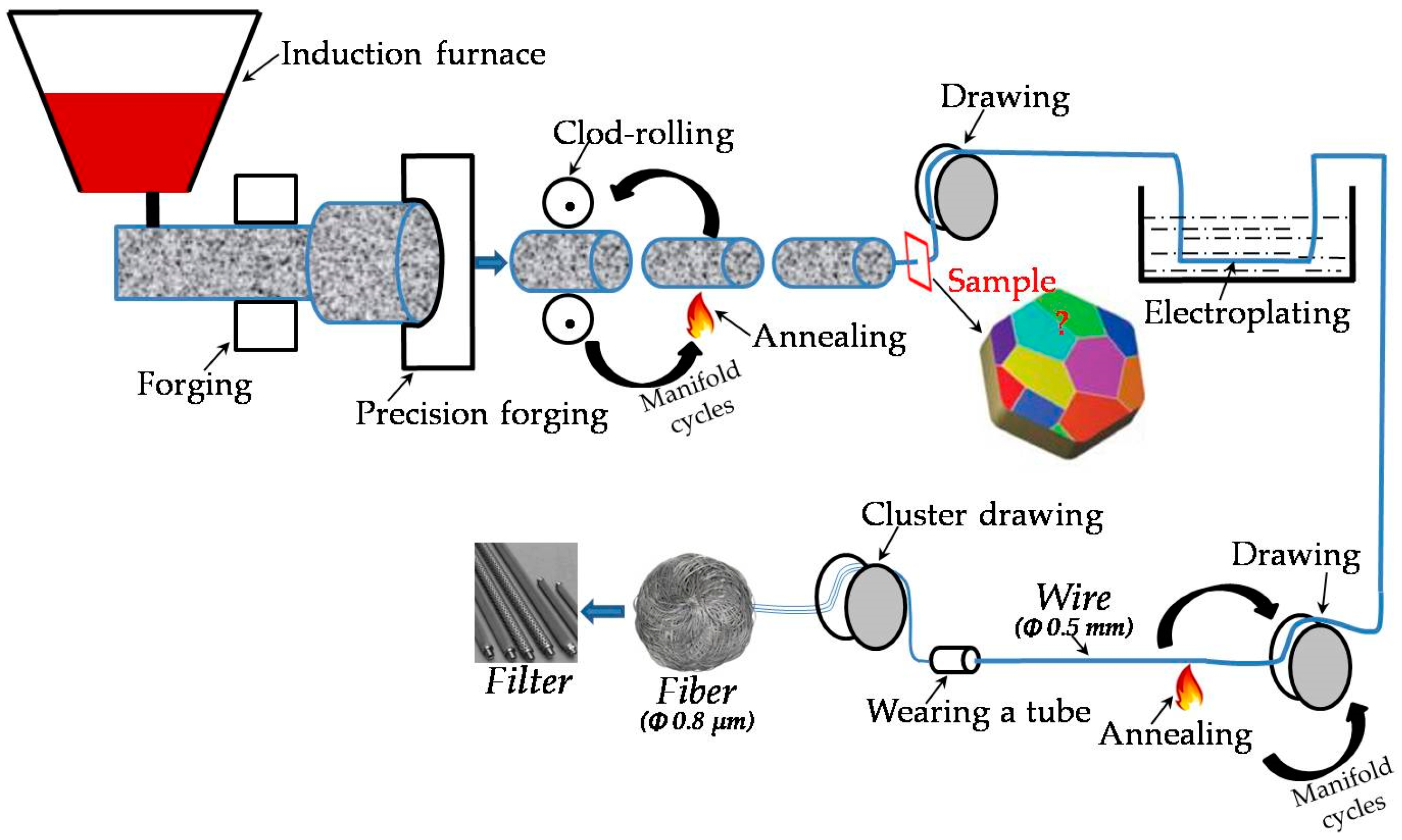

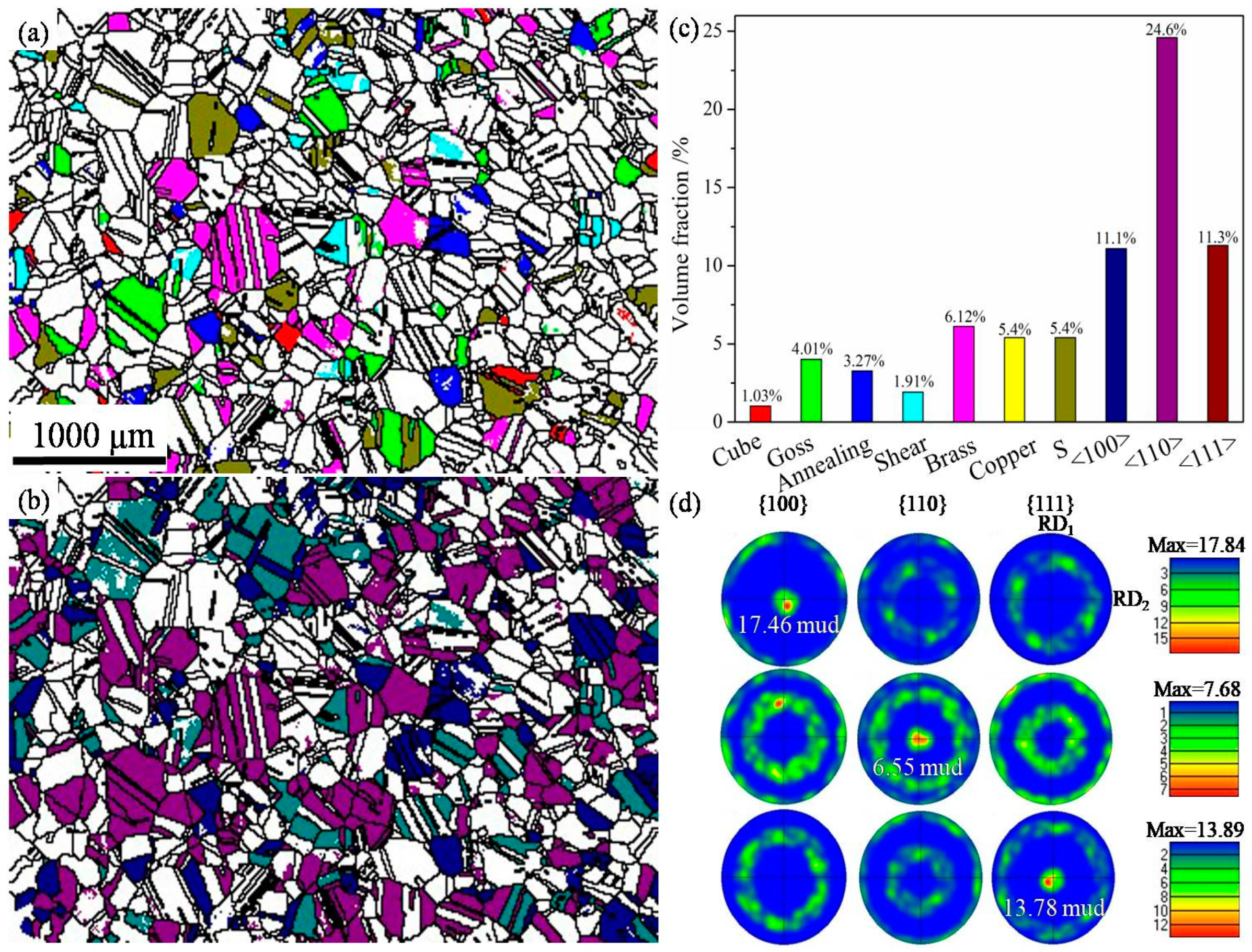
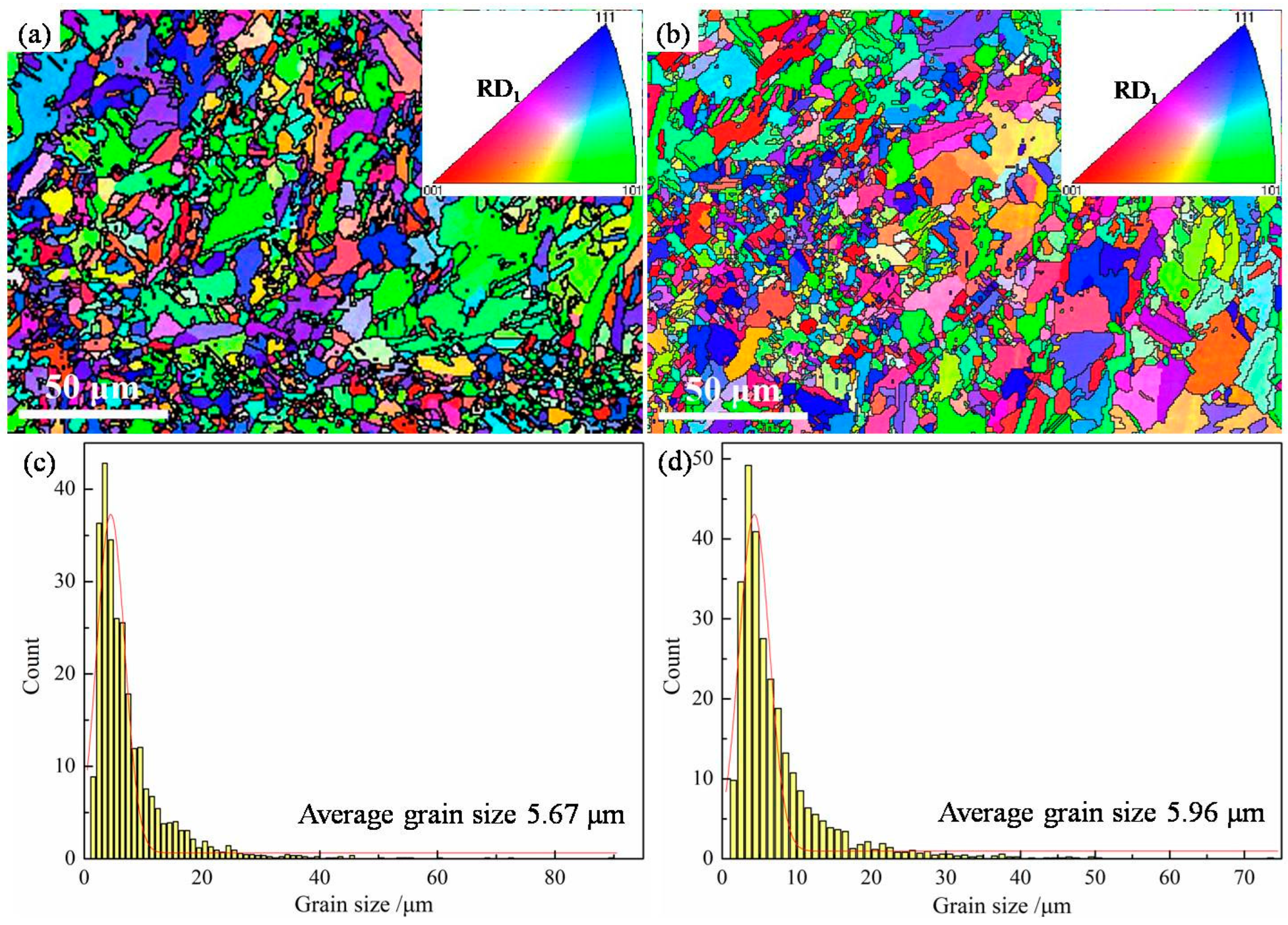
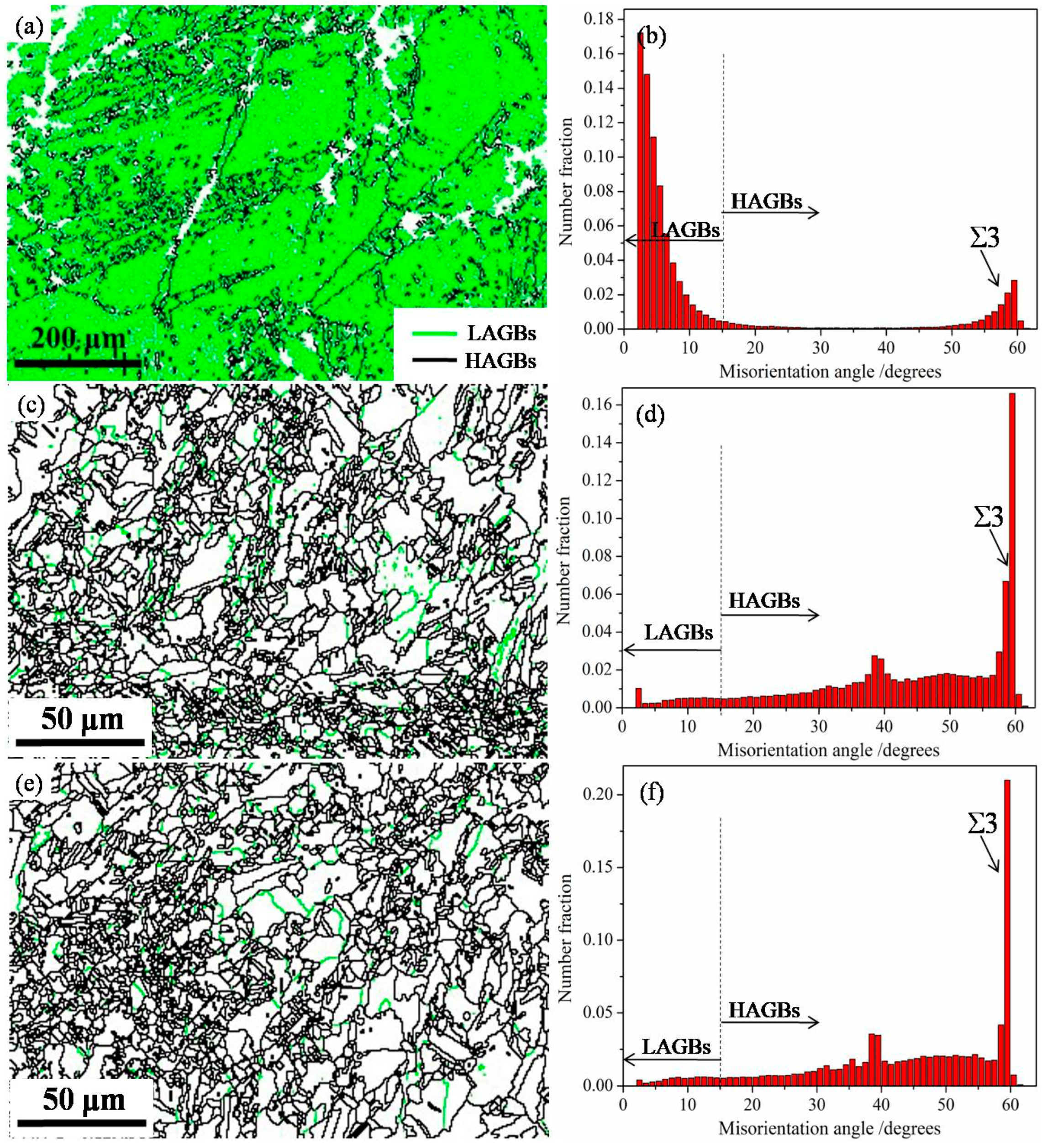


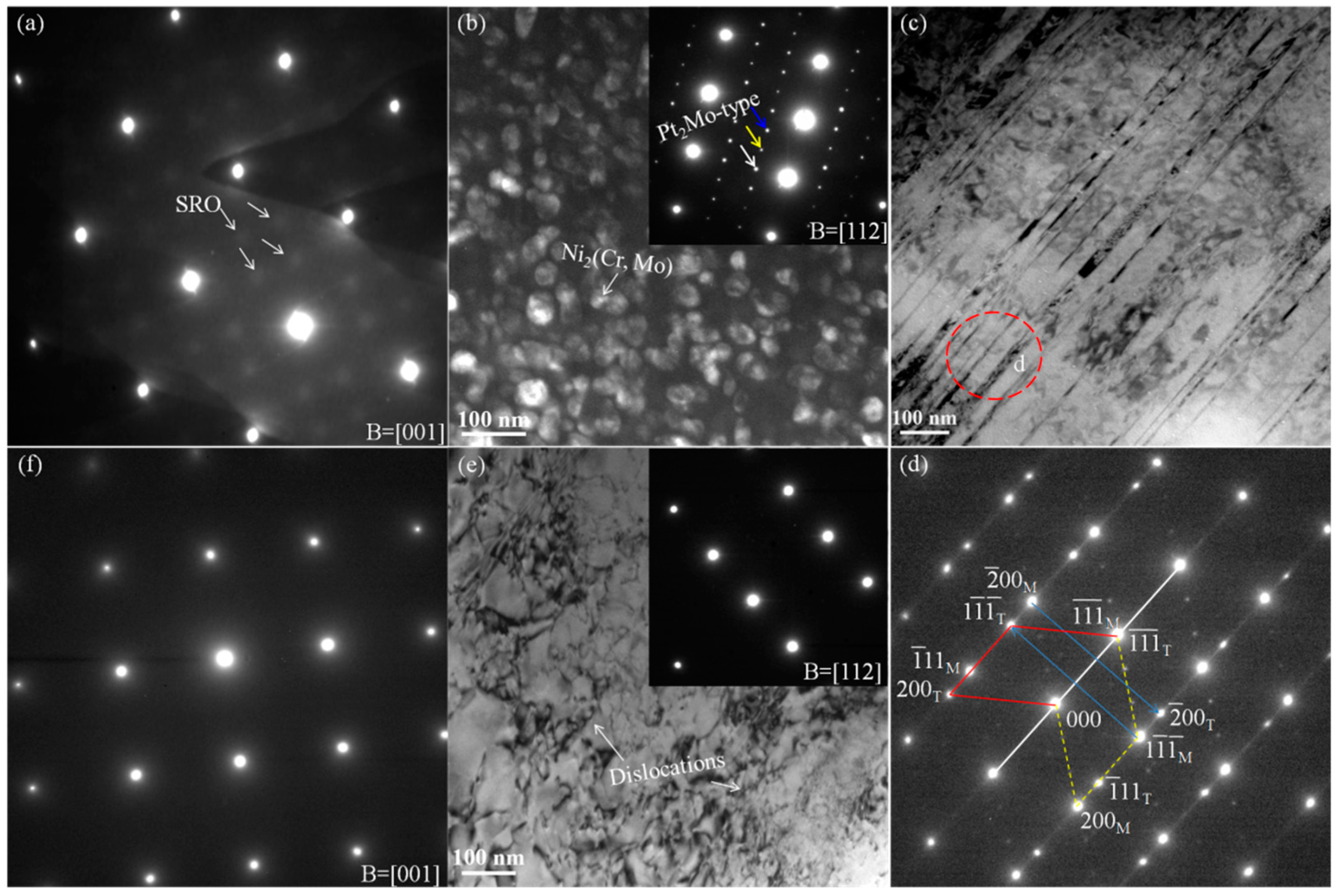
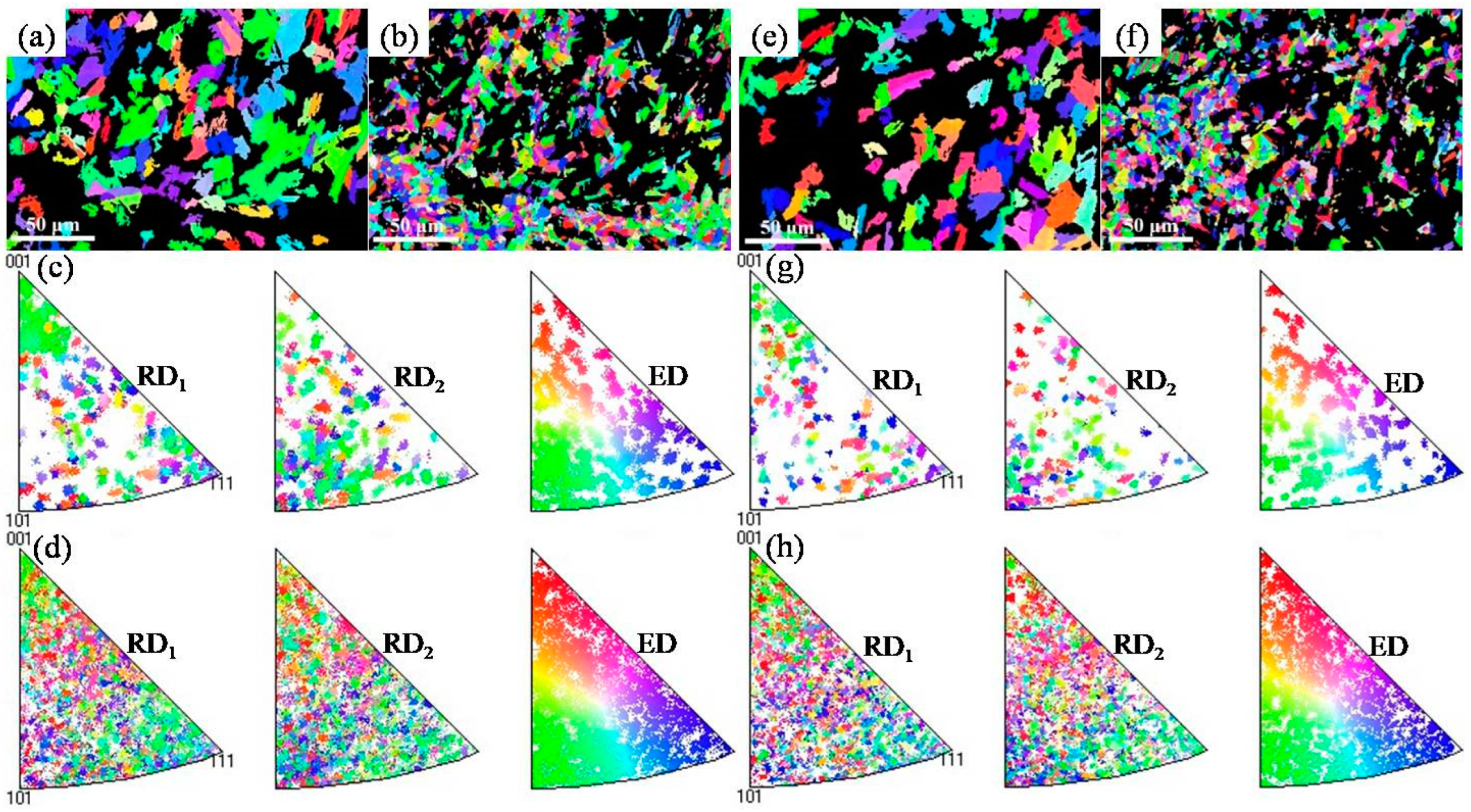
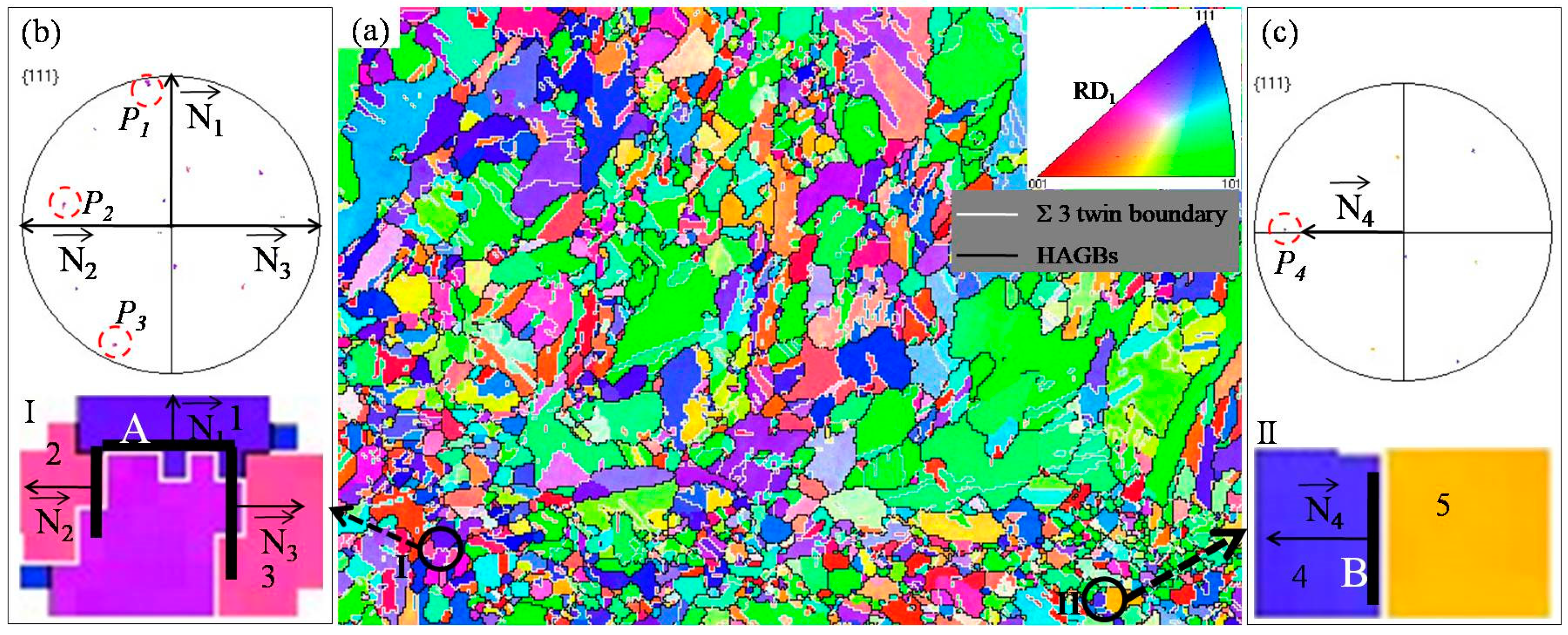
| Cr | Mo | Cu | Fe | Al | Mn | Co | Si | P | S | C | Ni |
|---|---|---|---|---|---|---|---|---|---|---|---|
| 22.66 | 15.8 | 1.53 | 0.75 | 0.24 | 0.23 | 0.20 | 0.02 | 0.003 | 0.001 | 0.001 | Bal. |
Disclaimer/Publisher’s Note: The statements, opinions and data contained in all publications are solely those of the individual author(s) and contributor(s) and not of MDPI and/or the editor(s). MDPI and/or the editor(s) disclaim responsibility for any injury to people or property resulting from any ideas, methods, instructions or products referred to in the content. |
© 2023 by the authors. Licensee MDPI, Basel, Switzerland. This article is an open access article distributed under the terms and conditions of the Creative Commons Attribution (CC BY) license (https://creativecommons.org/licenses/by/4.0/).
Share and Cite
Yuan, L.; Gou, F.; Sun, D.; Li, Z.; Xue, Y. The Effects of Cold Rolling and Annealing on the Microstructure Evolution of Ordered C-2000 Alloy during Metallic Wire Preparation. Metals 2023, 13, 651. https://doi.org/10.3390/met13040651
Yuan L, Gou F, Sun D, Li Z, Xue Y. The Effects of Cold Rolling and Annealing on the Microstructure Evolution of Ordered C-2000 Alloy during Metallic Wire Preparation. Metals. 2023; 13(4):651. https://doi.org/10.3390/met13040651
Chicago/Turabian StyleYuan, Liang, Faqiang Gou, Deqiang Sun, Zhiqiang Li, and Yunlong Xue. 2023. "The Effects of Cold Rolling and Annealing on the Microstructure Evolution of Ordered C-2000 Alloy during Metallic Wire Preparation" Metals 13, no. 4: 651. https://doi.org/10.3390/met13040651
APA StyleYuan, L., Gou, F., Sun, D., Li, Z., & Xue, Y. (2023). The Effects of Cold Rolling and Annealing on the Microstructure Evolution of Ordered C-2000 Alloy during Metallic Wire Preparation. Metals, 13(4), 651. https://doi.org/10.3390/met13040651





